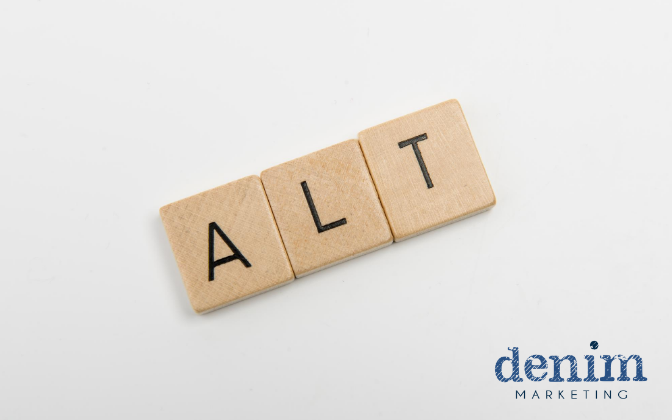
If you spend time writing blogs or website content, you’ve probably seen or are familiar with image alt text. Alt text, or alternative text, is often overlooked in search engine optimization (SEO) by novices since it’s not visible on the web page. However small, this piece of information plays a critical role in web page accessibility to visually impaired website visitors. And image alt text is a key component to incorporate for SEO to increase organic traffic.
What is Alt Text?
Alt text is written copy that is used to describe images on a web page. This text is found within the HTML code and is typically not visible on the page itself unless the image fails to load onto the reader’s screen.
Despite not being visible to web page viewers, this small form of text offers a variety of benefits to the accessibility of website and the business behind it. Visually impaired readers consume alt text when it is converted to audio describing the image on the page. Without this alt text, there would be no way to communicate these images to the reader.
Another benefit of using alt text is that it boosts web page relevance. If you’ve ever looked up a topic on Google, there are always a variety of links and images that immediately pop up onto the screen. In order to provide the most relevant websites, search engines look at the words on a page to determine what it is about. The alt text in photos, especially those that are detailed and specific, can help boost the topic relevance and place the site higher up in the search results. Not only does this drive more traffic to the site, but it also helps readers find information that is relevant to their search.
How To Use Alt Text
For most modern content management systems (CMS) such as WordPress, image alt text can be easily added without having to dig into the HTML code. In these CMS’s there is usually a field for alt text that shows up in the optimization window when adding an image to a page or post. Here, you will describe the image in detail. Some tips for effective alt text descriptions include:
- Be specific– The more specific the better. Pay close attention to the image subject and context and use that to guide your alt text descriptions. Read over the description carefully to make sure that the wording is clear.
- Be concise– Many screen reading tools stop reading and cut off lengthy alt text at a certain point. As a general rule, keep the alt text short and sweet. Aim for a description that has fewer than 125 characters.
- Avoid stating that it’s an image– One common alt text mistakes is stating that the image is an image. There is no need to include “Image of…” in the alt text. Search engines and screen readers pick that information up for themselves.
- Don’t overuse keywords– Alt text is not the place to be stuffing keywords into fragmented sentences. Search engines have a hard time understanding this kind of alt text and it can prevent them from ranking your site correctly. Include keywords if it can be easily included in the alt text but do so sparingly.
After the alt text added into the image optimization, it is automatically added to the webpage’s HTML code. Watch and see how organic traffic increases on those pages where alt text is used. The more optimized your images are, the better your websites SEO will be!
Does your business need help incorporating alternative text into your website images? Let the Denim Marketing team know! We offer strategic marketing and blogging services that includes SEO and alt text. Contact us today at 770-383-3360 or click here.
Leave a Reply